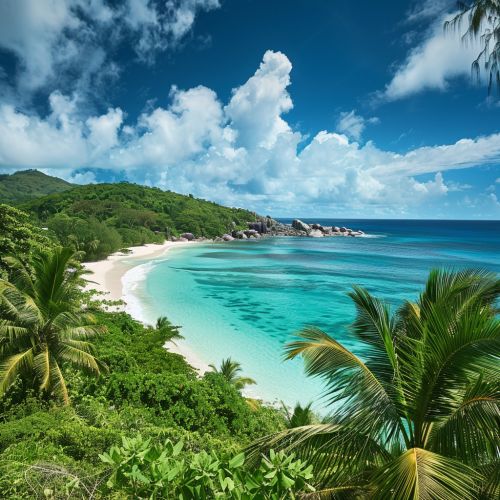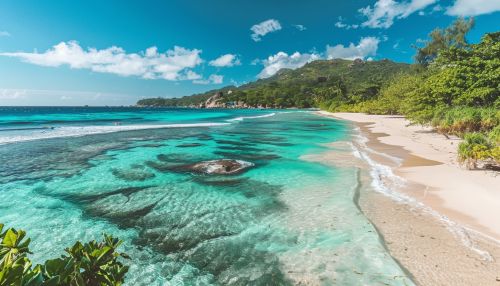Seychelles
Geography and Climate


The Seychelles archipelago, located in the Indian Ocean, comprises 115 islands, with the majority being granitic and the remainder coralline. The main islands include Mahé, Praslin, and La Digue, which host the majority of the population and economic activities. The granitic islands are characterized by rugged terrain, with the highest point being Morne Seychellois at 905 meters on Mahé. The coralline islands are generally flat and lack fresh water sources.
The climate of Seychelles is classified as tropical rainforest, with high humidity and temperatures averaging between 24°C and 30°C year-round. The archipelago experiences two main seasons influenced by the trade winds: the northwest monsoon from November to March, bringing warmer and wetter conditions, and the southeast trade winds from May to September, characterized by cooler and drier weather. The transitional periods between these seasons, known as the inter-monsoon periods, are marked by variable weather patterns.
History
The history of Seychelles is relatively recent compared to other regions. The islands were uninhabited until their discovery by European explorers in the 16th century. The first recorded sighting was by the Portuguese navigator Vasco da Gama in 1502. The French took formal possession of the islands in 1756, naming them after Jean Moreau de Séchelles, the French Minister of Finance.
In 1814, following the Treaty of Paris, Seychelles was ceded to the British. The islands remained a British colony until gaining independence on June 29, 1976. Post-independence, Seychelles became a republic within the Commonwealth. The early years of independence were marked by political instability, including a coup d'état in 1977 led by France-Albert René. René's socialist government ruled until 2004, when multi-party democracy was restored.
Demographics
The population of Seychelles is approximately 98,000, making it one of the least populous countries in the world. The ethnic composition is diverse, with the majority being of mixed African, Asian, and European descent, known as Seychellois Creole. The official languages are Seychellois Creole, English, and French. The predominant religion is Christianity, with Roman Catholicism being the largest denomination, followed by Anglicanism and other Christian sects. There are also small communities of Hindus, Muslims, and Bahá'ís.
Economy
The economy of Seychelles is primarily driven by tourism, which accounts for about 30% of the GDP and employs a significant portion of the workforce. The pristine beaches, coral reefs, and unique biodiversity attract visitors from around the globe. The second major sector is fishing, particularly tuna fishing, which is a vital source of revenue and employment.
Agriculture plays a minor role in the economy due to the limited arable land. The main agricultural products include coconuts, cinnamon, vanilla, and sweet potatoes. The government has been promoting economic diversification, focusing on sectors such as offshore financial services, information technology, and renewable energy.
Biodiversity and Conservation
Seychelles is renowned for its rich biodiversity, both terrestrial and marine. The islands are home to numerous endemic species, including the Seychelles giant tortoise, the Seychelles black parrot, and the Coco de Mer palm. The marine environment is equally diverse, with extensive coral reefs, seagrass beds, and a variety of fish species.
Conservation efforts in Seychelles are robust, with nearly half of the land area designated as protected areas, including national parks and nature reserves. Notable conservation projects include the restoration of island ecosystems, the protection of nesting sites for sea turtles, and the reforestation of native plant species. The Seychelles government, in collaboration with international organizations, continues to implement strategies to mitigate the impacts of climate change and promote sustainable development.
Culture
The culture of Seychelles is a vibrant blend of African, European, and Asian influences, reflected in its music, dance, cuisine, and festivals. Traditional music genres include moutya and sega, which are often accompanied by dance performances. The Creole Festival, held annually in October, celebrates the islands' cultural heritage with events showcasing traditional arts, crafts, and culinary delights.
Seychellois cuisine is characterized by the use of fresh seafood, tropical fruits, and spices. Popular dishes include grilled fish, octopus curry, and ladob, a dessert made from sweet potatoes, bananas, and coconut milk. The local markets, such as the Sir Selwyn Selwyn-Clarke Market in Victoria, offer a glimpse into the daily life and culinary traditions of the Seychellois people.
Government and Politics
Seychelles operates under a multi-party democratic system with a presidential republic framework. The President, who serves as both the head of state and government, is elected for a five-year term and can serve a maximum of three terms. The unicameral National Assembly, consisting of 35 members, is responsible for legislative functions. Members of the National Assembly are elected through a mixed system of direct and proportional representation.
The judiciary is independent, with the Supreme Court being the highest legal authority. Seychelles has a mixed legal system, incorporating elements of both civil law and common law traditions. The political landscape is dominated by two major parties: the United Seychelles Party and the Seychelles National Party.
Infrastructure
The infrastructure in Seychelles has seen significant development, particularly in the areas of transportation, telecommunications, and utilities. The main international gateway is the Seychelles International Airport on Mahé, which connects the islands to major global destinations. Inter-island travel is facilitated by domestic flights, ferries, and boats.
The road network is well-developed on the main islands, with public and private transportation options available. Telecommunications infrastructure has improved, with widespread mobile and internet coverage. The government has invested in renewable energy projects, particularly solar and wind power, to reduce dependence on imported fossil fuels and promote sustainability.
Education and Healthcare
Education in Seychelles is compulsory and free for children between the ages of 6 and 15. The education system comprises primary, secondary, and tertiary levels, with institutions such as the University of Seychelles offering higher education opportunities. The government places a strong emphasis on education, with a high literacy rate of over 90%.
Healthcare services in Seychelles are provided by both public and private sectors. The Ministry of Health oversees the public healthcare system, which includes hospitals, clinics, and health centers. The main hospital, the Seychelles Hospital, is located in Victoria. The government has implemented various health programs to address issues such as maternal and child health, infectious diseases, and non-communicable diseases.
See Also
- Indian Ocean
- Tropical rainforest climate
- Vasco da Gama
- Treaty of Paris (1814)
- Roman Catholicism
- Offshore financial services
- Renewable energy
- Moutya
- Sega (music)
- Civil law
